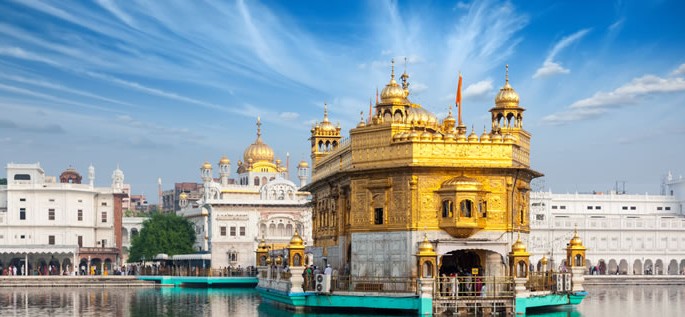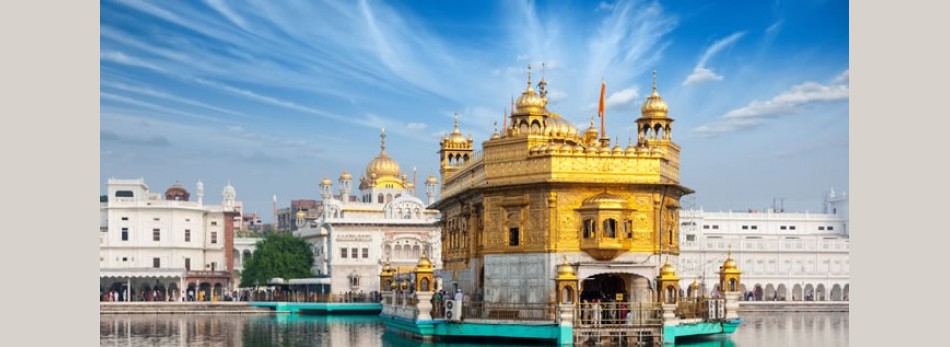Punjabi

Punjabi (also known as Pañjābī) is a member of the Indo-Aryan branch of the Indo-European language family. Eastern Punjabi is spoken as a first language primarily in the state of Punjab of India by 28.2 million people (Ethnologue). Western Punjabi (also known as Lahnda) is spoken by 60.6 million people in the Punjab province of Pakistan (Ethnologue). There are also speakers of these dialects in a number of other countries, including Afghanistan, Bangladesh, Kenya, United Kingdom, the U.S., and Canada. Nationalecyklopedin estimates the total number of first-language speakers of Punjabi at 100 million.
 Ancestors of the Punjabis are thought to have inhabited the Indus Valley at least as far back as 2,500 BCE. Indo-Aryan invasions had a significant effect on the language of the ancient Punjabis with the result that, like other Indo-Aryan languages, Punjabi evolved from Sanskrit through Prakrit, the latter being a large group of ancient Indic languages spoken between the 6th and the 13th centuries AD.
Ancestors of the Punjabis are thought to have inhabited the Indus Valley at least as far back as 2,500 BCE. Indo-Aryan invasions had a significant effect on the language of the ancient Punjabis with the result that, like other Indo-Aryan languages, Punjabi evolved from Sanskrit through Prakrit, the latter being a large group of ancient Indic languages spoken between the 6th and the 13th centuries AD.
- Eastern Punjabi is one of the 22 official languages and 14 regional languages of India. It is the medium of everyday communication in the Indian state of Punjab. It is used in education, government, business and in the media.
- Western Punjabi has no official status in Pakistan. Punjabi speakers in Pakistan use Urdu and English in government administration, the media, and education, as well as in most writing.
- Punjabi is the religious language of the Sikhs. It is also the language of the popular Bhangra folk dance and singing.
Dialects
There are numerous varieties of Punjabi that create a virtual continuum between Western and Eastern varieties of the language. For the most part, the dialects are mutually intelligible, even though there are differences in pronunciation and vocabulary. Punjabi expatriates around the world speak a creolized form of the language that is increasingly deviating from the norms of Punjabi spoken in India and Pakistan. Creolization is a process whereby a language evolves by incorporating elements of more than one language.
Structure
Punjabi is the only tonal Indo-Aryan language.
Vowels
Punjabi has ten vowel phonemes, i.e., sounds that make a difference in word meaning. Vowels can be short or long. Vowel length is marked by a macron, e.g., ā. Vowels can also be oral or nasal. Nasalization distinguishes word meaning. It is usually marked by a tilde over the vowel, e.g., ã.
|
Front
|
Central
|
Back
|
|
|---|---|---|---|
| Close |
i
|
u
|
|
| Mid |
e
|
o
|
|
| Open |
a
|
Consonants
Like all Indo–Aryan languages, Punjabi has a rich system of consonants. Its main features are summarized below.
- Consonant clusters are permitted mostly in medial and final positions. Initial clusters are infrequent and, usually consist of a consonant + /r/.
- Most consonants can be geminated (doubled).
- There is a contrast between aspirated vs. unaspirated voiceless stops and affricates, e.g., p—pʰ, t—tʰ, k—kʰ, tʃ – tʃʰ. Aspirated consonants are produced with a strong puff of air.
- There is a contrast between and apical vs. retroflex consonants, e.g., /t/ – /ʈ/, /d/ – /ɖ/, /n/ – /ɳ/,/l/ – /ɭ/, /r/ – /ɽ/. Apical consonants are produced with the tip of the tongue touching the roof of the mouth, whereas retroflex consonants are produced with the tongue curled, so that its underside comes in contact with the roof of the mouth.
|
Bilabial
|
Dental
|
Alveolar
|
Retroflex
|
Postalveolar/
palatal |
Velar
|
Glottal
|
||
|---|---|---|---|---|---|---|---|---|
| Stops | unaspirated voiceless | p | t |
ʈ
|
k | |||
| aspirated voiceless |
pʰ
|
tʰ |
ʈʰ
|
kʰ
|
||||
| voiced | d |
ɖ
|
g | |||||
| Fricatives | voiceless |
f
|
s
|
ʃ
|
x | h | ||
| voiced |
z
|
ɣ | ||||||
| Affricates | unaspirated voiceless |
tʃ
|
||||||
| aspirated voiceless |
tʃʰ
|
|||||||
| voiced | v |
dʒ
|
||||||
| Nasals | m | n |
..ɳ
|
ɲ
|
ŋ
|
|||
| Laterals | l |
.ɭ
|
||||||
| Flap or trill | r |
ɽ
|
||||||
| Approximant |
ʋ
|
- /ʃ/ = sh in shop
- /x/ has no equivalent in English
- /ɣ/ has no equivalent in English
- /tʃ/ = ch in chop
- /dʒ/ = j in job
- /ɲ/ = first n in canyon
- /ŋ/ = ng in song
- /ɭ/ has no equivalent in English
- /ʋ/ can be pronounced as /w/ or /v/.
- /j/ = y in yet
Tones
Punjabi has three tones: High, Mid, and Low. The tone of a word is a pitch pattern permanently associated with it. A change of tone changes the meaning of a word.
Stress
Stress in Punjabi can fall on any syllable of a word, and can differentiate otherwise identical words. In general, stress falls on the penultimate (one before last) syllable unless the syllable ends in a short vowel. If so, then the stress fall on the antepenultimate (second from the end) syllable.
Punjabi grammar is similar to that of other Indo-Aryan languages. Like all these languages, Punjabi is agglutinative, i.e., it adds suffixes to roots to build words and to express grammatical relations.
Nouns, adjectives
Punjabi nouns are marked for the following grammatical categories:
- number: singular and plural;
- gender: masculine, feminine;
- case: nominative, genitive, accusative–dative, instrumental, ablative, locative, and vocative; all cases, except vocative, are marked by postpositions; the vocative case may be marked by a vocative particle or term of address;
- absence of definite or indefinite articles;
- adjectives agree with the nouns they modify in gender, number, and case;
Verbs
Verbs agree with their subjects (active voice), or with their objects (passive voice) in person, number and gender. Verbs have a number of features listed below.
- There are three persons: 1st, 2nd, 2nd honorific, 3rd.
- There are two numbers: singular and plural;
- There are three tenses: present, past, future.
- There are two aspects: imperfective and perfective.
- There are three moods: indicative, imperative, subjunctive, conditional
- There are two voices: active and passive.
Word order
The normal word order in Punjabi is Subject – Object – Verb. Modifiers precede the nouns they modify. Indirect objects precede direct objects.
The basic vocabulary of Punjabi is Sanskrit in origin, but over the years Punjabi has borrowed words from other languages. Eastern Punjabi has many Hindi and English loanwords, while Western Punjabi contains many borrowings from Persian, Arabic and Urdu.
Below are the Punjabi numerals 1-10 in romanization.
|
1
|
2
|
3
|
4
|
5
|
6
|
7
|
8
|
9
|
10
|
|---|---|---|---|---|---|---|---|---|---|
|
yk
|
do
|
tyn
|
car
|
peñj
|
che
|
set
|
et
|
neung
|
des
|
Punjabi numerals 0-9 in Gurmukhi script are given below.
![]()
Below are a few common words and phrases in Punjabi.
| Hello | Sat shri akaal (Sikhs)Namaste (Hindus)Assalaam alaikam (Muslims) |
| Goodbye | Sat siri akaal (Sikhs, Hindus)Khudaa haafiz (Muslims) |
| Yes | Haan ji |
| No | Naheen |
| Please | Merhebani kerke |
| Excuse me | Maf karna |
Writing
Punjabi’s literary tradition started at the end of the 16th century after the development of the Gurmukhi script, even though there are some literary pieces dating back to the 12th century AD. Today, Punjabi is written with three different scripts.
|
Devanagari
|
Hindus sometimes use the Devanagari script to write Punjabi. |
|
Gurmukhi
|
Within the Indian state of Punjab, Sikhs tend to use the Gurmukhi script. Like Devanagari, Gurmukhi is a script in which each consonant has an inherent [a] vowel which can be modified by vowel symbols that can be attached to the consonant. Gurmukhi has 53 symbols. Like Devanagari, Gurmukhi is written from left to right. |
|
Shahmukhi
|
Punjabis in Pakistan use a modified Arabic script called Shahmukhi, a modified version of the Persian Nasta’liq script. It is written from right to left. |
Take a look at Article 1 of the Universal Declaration of Human Rights in Gurmukhi, Shahmukhi and in transliteration.
|
Gurmuki
ਸਾਰਾ ਮਨੁੱਖੀ ਪਰਿਵਾਰ ਆਪਣੀ ਮਹਿਮਾ, ਸ਼ਾਨ ਅਤੇ ਹੱਕਾਂ ਦੇ ਪੱਖੋਂ ਜਨਮ ਤੋਂ ਹੀ ਆਜ਼ਾਦ ਹੈ ਅਤੇ ਸੁਤੇ ਸਿੱਧ ਸਾਰੇ ਲੋਕ ਬਰਾਬਰ ਹਨ। ਉਨ੍ਹਾਂ ਸਭਨਾ ਲੂੰ ਤਰਕ ਅਤੇ ਜ਼ਮੀਰ ਦੀ ਸੌਗਾਤ ਸਿਲੀ ਹੋਈ ਹੈ ਅਤੇ ਉਨ੍ਹਾਂ ਲੂੰ ਭਰਾਤਰੀਭਾਵ ਦੀ ਭਾਵਨਾ ਰਾਖਦਿਆਂ ਆਪਸ ਵੀਚਾ ਵਿਚਰਣਾ ਚਾਹੀਦਾ ਹੈ।Punjabi’s literary tradition is relatively new. It started at the end of the 16th century following the development of the Gurmukhi script, even though there are some literary pieces dating back to the 12th century AD.ਸਾਰਾ ਮਨੁੱਖੀ ਪਰਿਵਾਰ ਆਪਣੀ ਮਹਿਮਾ, ਸ਼ਾਨ ਅਤੇ ਹੱਕਾਂ ਦੇ ਪੱਖੋਂ ਜਨਮ ਤੋਂ ਹੀ ਆਜ਼ਾਦ ਹੈ ਅਤੇ ਸੁਤੇ ਸਿੱਧ ਸਾਰੇ ਲੋਕ ਬਰਾਬਰ ਹਨ। ਉਨ੍ਹਾਂ ਸਭਨਾ ਲੂੰ ਤਰਕ ਅਤੇ ਜ਼ਮੀਰ ਦੀ ਸੌਗਾਤ ਸਿਲੀ ਹੋਈ ਹੈ ਅਤੇ ਉਨ੍ਹਾਂ ਲੂੰ ਭਰਾਤਰੀਭਾਵ ਦੀ ਭਾਵਨਾ ਰਾਖਦਿਆਂ ਆਪਸ ਵੀਚਾ ਵਿਚਰਣਾ ਚਾਹੀਦਾ ਹੈ। |
|
Shakhmuki
سارے انسان آزاد تے حقوق تے عزت دے لحاظ نال برابر پیدا ہوندے نیں. اوہ عقل سمجھ تے چنگے مندے دی پچھان تے احساس رکھدے نے ایس واسطے اوہناں نوں اک دوجے نال بھائی چارے والا سلوک کرنا چاہی دا اے. |
|
Transliteration
Sārē insān āzād atē hak tē izat dē lihāz nāl barābar paidā hudē hana. Uh akal, samajha tē cagē madē dī pachāṇ atē ahisās rakhadē han, is la’ī uhanāṁ nū ik dūjē nāl bhā’īcārē vālā salūk karnā cāhīdā hai. |







